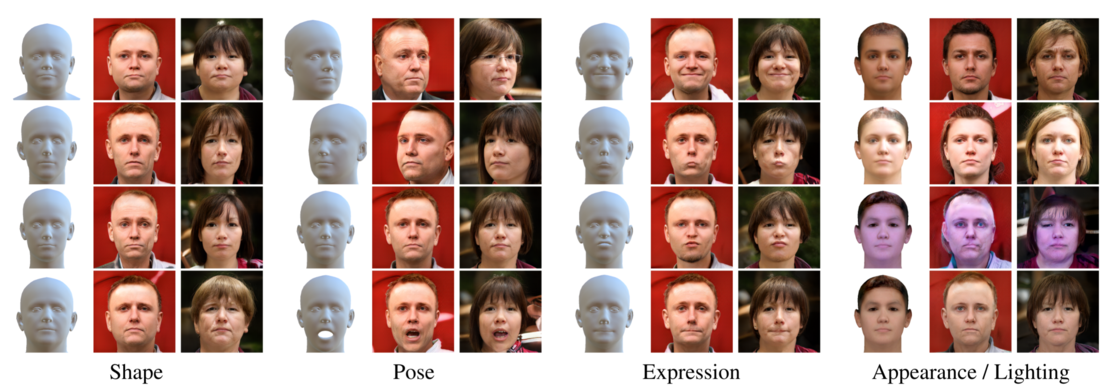GIF
Generative Interpretable Faces
Partha Ghosh, Pravir Singh Gupta*, Roy Uziel*, Anurag Ranjan, Michael J. Black and Timo Bolkart (*authors contributed equally)
International Conference on 3D Vision (3DV) 2020

Face images generated by controlling FLAME parameters, appearance parameters, and lighting parameters. For shape and expression, two principal components are visualized at ±3 standard deviations. The pose variations are visualized at ±π/8 (head pose) and at 0,π/12 (jaw pose). For shape, pose, and expression, the two columns are generated for two randomly chosen sets of appearance, lighting, and style parameters. For the appearance and lighting variations (right), the top two rows visualize the first principal component of the appearance space at ±3 standard deviations, the bottom two rows visualize the first principal component of the lighting parameters at ±2 standard deviations. The two columns are generated for two randomly chosen style parameters.
Abstract
Photo-realistic visualization and animation of expressive human faces have been a long standing challenge. 3D face modeling methods provide parametric control but generates unrealistic images, on the other hand, generative 2D models like GANs (Generative Adversarial Networks) output photo-realistic face images, but lack explicit control. Recent methods gain partial control, either by attempting to disentangle different factors in an unsupervised manner, or by adding control post hoc to a pre-trained model. Unconditional GANs, however, may entangle factors that are hard to undo later. We condition our generative model on pre-defined control parameters to encourage disentanglement in the generation process. Specifically, we condition StyleGAN2 on FLAME, a generative 3D face model. While conditioning on FLAME parameters yields unsatisfactory results, we find that conditioning on rendered FLAME geometry and photometric details works well. This gives us a generative 2D face model named GIF (Generative Interpretable Faces) that offers FLAME's parametric control. Here, interpretable refers to the semantic meaning of different parameters. Given FLAME parameters for shape, pose, expressions, parameters for appearance, lighting, and an additional style vector, GIF outputs photo-realistic face images. We perform an AMT based perceptual study to quantitatively and qualitatively evaluate how well GIF follows its conditioning. The code, data, and trained model are publicly available for research purposes.
More Information
- pdf preprint
- video
- code
- input files
- Checkpoints
- GIF Project page at MPI-IS
- For questions, please contact gif@tue.mpg.de
Referencing GIF
@inproceedings{GIF2020,
title = {{GIF}: Generative Interpretable Faces},
author = {Ghosh, Partha and Gupta, Pravir Singh and Uziel, Roy and Ranjan, Anurag and Black, Michael J. and Bolkart, Timo},
booktitle = {International Conference on 3D Vision (3DV)},
pages = {868--878},
year = {2020},
url = {http://gif.is.tue.mpg.de/}
}